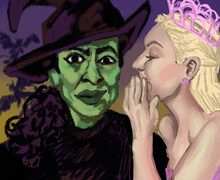Beauty industry, social media impress unhealthy standards onto youth
Leah Bowman | Contributing Illustrator
Young girls running rampant in Sephora point to a much larger issue. Our columnist writes that the increase in cosmetic consumption is a result of body insecurity perpetuated by social media.
Get the latest Syracuse news delivered right to your inbox.
Subscribe to our newsletter here.
Sephora obsessed pre-teens have taken over my TikTok For You page, and frankly it scares me. Not because I don’t think I could fight a 7-year-old over the last in-stock Drunk Elephant bronzing sun drops, but because the beauty industry’s hold on women has now grasped children in a way I’ve never seen before.
Of course, young girls absorbing beauty standards is not really a new phenomenon, but it is jarring to see the normalization of girls filming “get ready with me” videos and beauty hauls imitating the same adult influencers I watch. My first instinct was to question the parents of these young girls, and how they could allow their children to purchase such costly beauty products, let alone post videos of themselves with them. But on second thought, I reconsidered ascribing individual blame to the families of these girls.
While I do believe some criticism of these parents is still fair, I also know that even parents who don’t allow their daughters to prematurely buy Charlotte Tilbury cannot protect young girls from our society’s obsession with beauty.
I’m also not exempt from succumbing to the capitalist and patriarchal mirage of being able to “finally” reach impossible beauty standards — even when it’s at the detriment of my wallet or causes me guilt over my bad feminist indulgences. In fact, as a self-proclaimed luxury beauty product connoisseur and aficionado of various cosmetic treatments, I know the struggle all too well.
While we should examine our internal beliefs on what it means to be pretty and look into our consuming habits, it would be hypocritical of me to advise everyone to just “work hard” to overcome their personal insecurities and simply “not buy” such products. Regardless of our best efforts, it would be impossible to pretend we can enter a bubble free from outside pressure to change our habits.
The brunt of responsibility lies within the industries that prey on women’s insecurities, not even caring to safe-guard young girls from the same exploitation.
According to a report from the Dove Self-Esteem Project and Harvard’s Strategic Training Initiative for the Prevention of Eating Disorders, “harmful beauty ideals cost the U.S. economy $305 billion due to body dissatisfaction and $501 billion due to appearance-based discrimination annually.” On average, women in the United States spend $75 per month on cosmetic products.
The sheer amount of money spent on appearance alone may seem unfathomable, but it makes sense when we consider all the ways women are expected to “maintain” their looks. A complete makeup collection includes dozens of beauty products and exhausting regimens of multi-step skin care require cleansers, serums, oils and creams. Women also regularly spend an abundance of time, effort and money on hair, nails or lash treatments. These are just the basics.
There’s also costs spent on plastic surgery, fat transfers and removal, laser hair removal, filler and other injectables. And new twisted ways to “invest in yourself” keep popping up like the Brazilian butt lift (BBL), lip flip and nipple-size reductions. The overwhelming options to modify oneself creates a sense of obligation in women to change, making it difficult to resist embracing one’s natural features.

Cindy Zhang | Digital Design Director
Beauty standards are also based in racist, white supremacist standards that disproportionately affect women and girls of color. A Columbia University study titled “The Beauty Ideal: The Effects of European Standards of Beauty on Black Women” found for young Black women that “internalization of racialized beauty standards can perpetuate into a lifelong, intergenerational culture of self-hatred.” Skin lightening treatments, eye-shape and lid surgeries, chemical hair straightening are aimed at women of color to push them to resemble eurocentric beauty ideals.
Racialized beauty standards also create a host of health problems, as chemicals often found in such products include endocrine disruptors that lead to uterine and breast cancer. On the other hand, certain surgeries and styles allow white people to mimic features typical for women of color, termed as “blackfishing,” “mixed-fishing” and “ethnic smudging” (think: Kylie Jenner and Iggy Azalea) to look vaguely exotic. According to white beauty standards, women of color in their entirety are unacceptable and undesirable, yet copy and pasting their features onto white women is ideal.
To rake in billions, one tactic employed by the beauty industry is to profit from “new” but unnecessary beauty trends, which they create. For example, the “strawberry makeup” look went viral on TikTok, with thousands of videos under the #strawberrymakeup which coincidentally coincided with Hailey Bieber’s launch of the Strawberry Glaze Peptide treatment for her skincare company rhode.
With the increasing use of social media and rise in screentime from children, it can be suspected that young girls, wanting to emulate older girls and women they see on their TikTok accounts, follow suit in consuming whatever product is popularized by these manufactured trends. To not only protect younger girls, but ourselves as well, America’s beauty industry and social media companies need more regulation, such as banning beauty product advertisements and content for minors and requiring transparency from influencers when advertising and promoting for all.
Emane Haque is a senior Magazine Journalism major. Her Column appears bi-weekly. She can be reached at eohaque@syr.edu
Published on February 6, 2024 at 12:27 am






